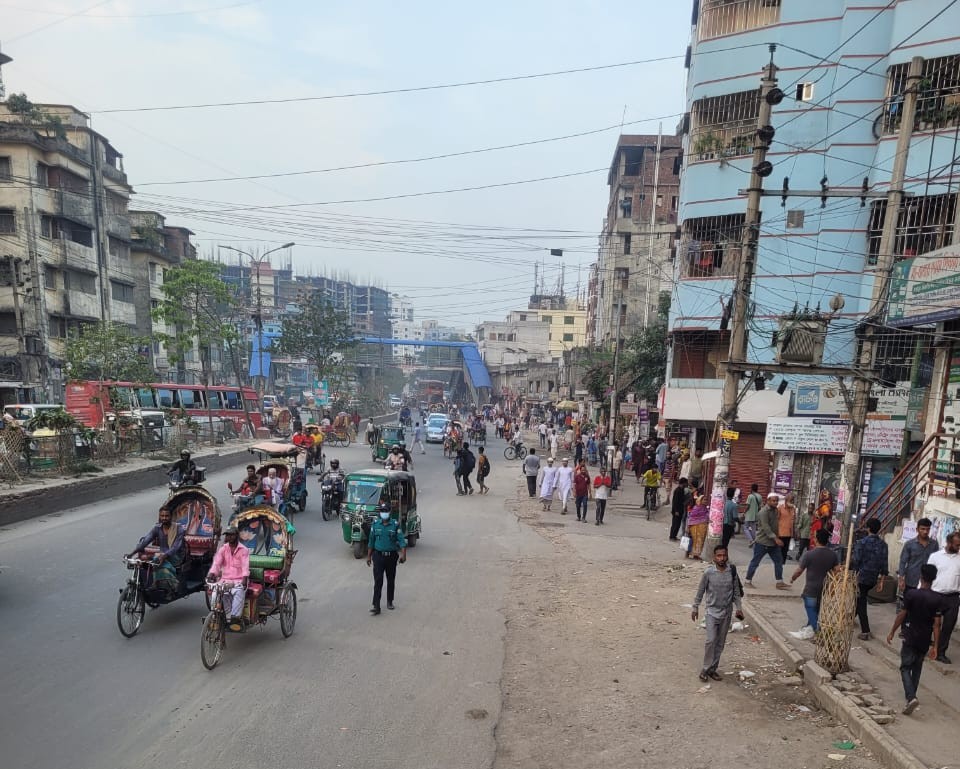What was once a daily nightmare for commuters travelling through the Mohammadpur-Bosila area has now transformed into a model of traffic management, thanks to a set of strategic and proactive measures taken by the traffic police under the Mohammadpur zone. The once chronic traffic congestion in the Bosila area is now nearly nonexistent, earning widespread praise from commuters and residents.
The centerpiece of the traffic management strategy was the complete shutdown of the Beribadh signal. Instead, a U-turn system was introduced: vehicles heading from Gabtoli to Babu Bazaar now take a U-turn from Mayur Villa, while vehicles travelling in the opposite direction take a U-turn from Lautola. A direct route between Mohammadpur bus stand and Bosila was also opened to ease vehicle movement.
Authorities also removed over a hundred illegal shops, unauthorized bus and CNG stands, and street vendors, significantly widening the roads. The Dhaka Power Distribution Company (DPDC)’s previously excavated roads were also refilled with brick chips and rubble, and uneven roads were levelled. The Beribadh culvert road was also repaired to ensure a smooth ride.
Md. Aslam Sagar, assistant commissioner of traffic police for Mohammadpur zone, told Times of Bangladesh that closing the Beribadh signal and introducing U-turns played a key role in reducing congestion.
A temporary median island made of concrete blocks has been installed on the Bosila-Gabtoli-Rayerbazar link road to enforce lane discipline, further contributing to the smoother traffic flow.
Traffic Inspector Zahidul Islam added that coordinated field-level implementation of the plan by all traffic officers was crucial to the success.
Maruf Hasan, a private service holder and local resident, said, “It used to take over 30 minutes just to cross Mohammadpur Bus Stand. Now, vehicles pass without even stopping once. The relief from congestion is beyond words.”

Sohel Mahmud, a resident of Lavoni area in Bosila, said, “I used to consider moving out from the area because of the terrible traffic. Now, there’s no hassle — commuting is much easier.”
However, he added a concern: “On the way to Bosila, there’s still a group blocking the left side of the road near the U-turn with a brick and sand business. If they’re removed, things will be even better.”
According to Tejgaon traffic division, a dedicated left lane has been created west of Bangladesh Eye Hospital at Dhanmondi 27. As a result, vehicles coming from the east can now travel seamlessly along Sat Masjid Road, take a U-turn, and head towards Mohammadpur Bus Stand without encountering multiple signals. Where previously three traffic signals were needed, now only two are sufficient.
Commuting between Mohammadpur Bus Stand and Sat Masjid Road in both directions has also become easier, with a notable reduction in congestion.
Behind this success is the relentless effort of the Tejgaon traffic division.
ADC Tania Sultana of the Tejgaon Traffic Division told Times of Bangladesh that challenges remain, including mobile vendors returning to cleared areas, disputes with CNG and e-rickshaw drivers, and problems caused by uncarpeted, dusty, or muddy roads. She emphasized the need for regular maintenance and enforcement of law to sustain improvements.
Md. Rafiqul Islam, DC of the Tejgaon traffic division said, “The ‘magical’ transformation of Mohammadpur, Bosila, and Dhanmondi 27 proves that with strong intent, integrated planning, and determined action, we can reduce traffic congestion even with limited resources.”
He further noted that the traffic police’s innovative efforts have brought tangible relief to Dhaka’s residents and have set an example for other gridlocked areas in the city.
The Roads and Highways Department and City Corporation must construct permanent carpeting and proper median islands/U-turns, he said.
While the improvements are commendable, DC Rafiqul emphasized the need for long-term solutions.


